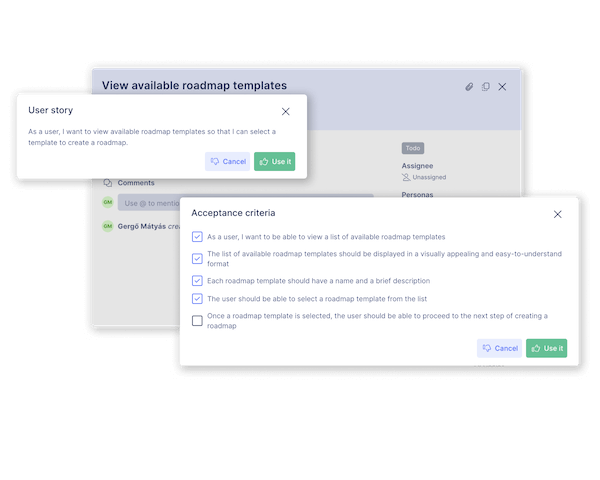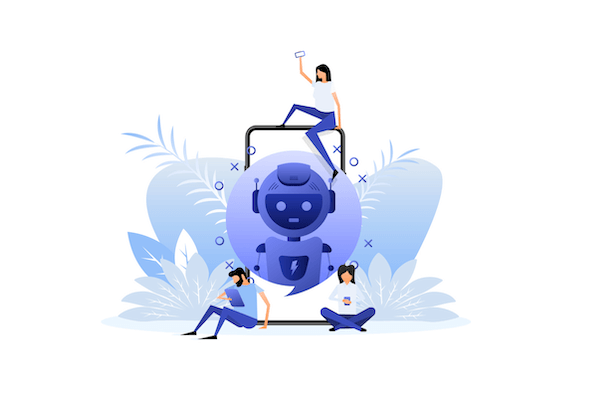In this article, we will explore how AI technology can help you generate user stories, saving you time and effort while improving the quality of your projects.
User stories play a crucial role in Agile software development, helping Product Owners, Product Managers, Business Analysts, Designers, and Developers understand the needs and requirements of their users. Traditionally, these stories are created by human professionals based on their understanding of the project and many years of expertise.
However, AI-created user stories are offering a new level of efficiency and creativity, and an opportunity to test our capabilities and expertise in user story creation.
Fortunately, with the advancements in Artificial Intelligence (AI) technology, generating user stories has become easier and more efficient than ever before. AI-powered tools can analyze vast amounts of data, user feedback, and industry trends to generate high-quality user stories that align with your project goals, becoming something like a virtual partner involved in the brainstorming process who can bring new ideas and approaches.
Contents
What is a user story?
A user story is a brief description of a product feature, capability, or task that should be implemented for the end user. It is written from the perspective of the user and it’s about a goal that the user wants to achieve with using the planned software.
User stories are becoming an increasingly important part of the Agile methodology. Written in a specific format, they provide simple and concise descriptions of features. This helps teams communicate and collaborate on projects clearly, concisely, and effectively, preventing misunderstandings and the resulting overwork and loss of time and money.
User stories provide teams with a better understanding of what users want, allowing them to develop features geared towards optimized user journeys and user experience.
What are the benefits of user stories?
- User stories help to keep the focus and prioritize the end-user’s intentions, goals, and needs during the software development process
- User stories allow Agile teams to break down complex projects into smaller, achievable tasks that can be worked on incrementally
- User stories are written in plain language and built on a simple formula: As a [type of user or role], I want to [end goal] so that I [do this]
- A good user story is estimable and testable.
What are the acceptance criteria?
User stories are usually accompanied by acceptance criteria – that detail what must be done for the story to be considered complete.
Acceptance Criteria (AC) are the lowest-level functional requirements that a software product must meet to be accepted by users or customers and to be compatible with other systems. They apply to each user story and describe functionality from the end-user’s perspective.
Why Do You Need Acceptance Criteria?
- Acceptance criteria help the software development team understand and test whether the user story works as expected
- Acceptance criteria help to align the ideas of the customer, the stakeholders, and the software development team
- Acceptance criteria help create automated tests, so ACs are written with a base of a clear Pass / Fail result.
Why use AI to generate user stories?
The use of AI technology to generate user stories offers several advantages compared to manually created user stories.
Firstly, AI-generated user stories are created faster. Secondly, they are more accurate and efficient since they have been generated through the analysis of large amounts of data and customer feedback.
Creating Agile user stories can be a lengthy and overwhelming process. As such, AI technology has been developed to automate certain aspects of this process to reduce costs and time spent manually managing stories. AI-powered user story generation tools provide an overview of customer needs quickly and accurately without losing any meaning or context from the original intent behind the feature request.
The resulting output is efficient and easily understood by product teams, clients, and stakeholders taking away much of the manual effort associated with manual story creation.
If you don’t have much experience in writing user stories, AI assistance is a good way to learn how to write concise product visions, generate user stories, and get the job done faster and more efficiently. User story templates and examples are very useful for practicing user story creation, but AI is faster and guarantees the same quality as if it were created by the most experienced professionals.
If you’re a pro user story writer, incorporating AI-generated user stories into your process still has advantages. Not only will AI user story generation provide you with fresh ideas, but it will also fill any existing gaps in your work.
How to generate user stories with StoriesOnBoard?
To continue working on this story map, you need to sign up to StoriesOnBoard, and then you can try out our other product management features like story mapping, roadmaps, prioritization, and feedback management.
Start with a more sophisticated AI assistance
Start a trial or a new project in Storiesonboard and add some details to generate user stories, such as the purpose of your project, the product type, its key features, the target users, etc.

After that create some goals and user steps, and then you’ll arrive at the user story card creation step. The AI feature will offer some user stories to select those that are relevant to your project. Place them on the story map, under the user goals and steps they belong.
Choose a card to generate user stories with acceptance criteria and other details, and the AI will do the job for you. You can re-generate user stories if you don’t like the ones the app offers, and you can choose which acceptance criteria you’d like to use in your project.
User story creation can be that simple.
Now you have a complete story map, but if you’d like to use user stories or acceptance criteria elsewhere you can easily copy and paste them into another app.

Build better products faster.
Get started with StoriesOnBoard today!
14-day Free Trial. No Credit Card is Required.
Is this AI user story generator reliable?
Absolutely. StoriesOnBoard uses Open AI, and with the project information you entered at the beginning of the process create a detailed prompt to generate user stories and other effective and original content for you.
Plus, StoriesOnBoard allows you to customize the AI-generated user stories by editing or deleting them. That way, you can have complete control over the stories created and keep them as close as possible to your project’s needs.
Conclusion
Writing user stories manually can be challenging, particularly when dealing with a complex project and multiple user personas. AI-powered user story generators offer a solution by streamlining the process and providing objective assessments to ensure alignment with customer needs.
StoriesOnBoard’s AI tool is a powerful tool for Product Owners, Product Managers Business Analysts, or even Designers to use at the beginning of their software development processes. It helps them generate accurate and efficient user stories and acceptance criteria, gather new ideas, fill the gaps, and create a story map from scratch to discuss with their agile teams, clients, and stakeholders.
